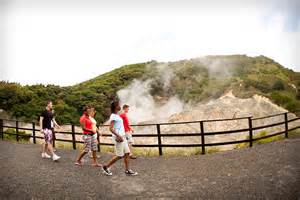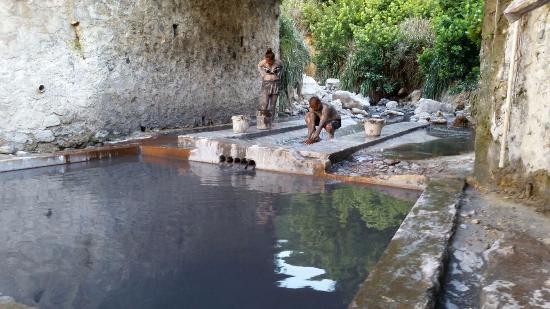St. Lucia is one of the few volcanic islands in the Caribbean and the only one with a mud Bath!
The leader in St Lucia Tourism
Situated some 42 km along a precipitous ribbon shaped road from the capital Castries and about 2.4 km south east of the picturesque town of Soufriere, is a geologic marvel and St. Lucia’s most famous and premiere visitor attraction, Sulphur Springs Park. Advertised worldwide as the home of the, “World’s Only Drive-In Volcano”; for the visitors ability to drive and walk right into the heart of a dormant volcano, the park attracts over 200,000 patrons annually.
|
At Sulphur Springs Park you are in the middle of a dormant volcano and on the site of the last recorded eruption in St. Lucia in 1766. As expected, the immediate area is heavily bruised from the intense volcanic activity experienced in the formation of the south western part of the island. The park’s main attraction is its sulphur springs - an impressive collection of boiling springs and fumeroles that is seated 305 metres above sea level, between the Rabot Ridge and Terre Blanche.
|
The springs, from which the area gets its name, Sulphur Springs, occurs at the intersection of two fault lines which traverse the centre of a large steep sided volcanic depression, called “Qualibou” caldera. This caldera is about 32, 000 to 39,000 years old.
Its 46 hectares spreads majestically between two hills that are centrally located within St. Lucia’s Piton World Heritage Site; a status accorded by the United Nations Educational Scientific and Cultural Organization (UNESCO) for the area’s outstanding universal beauty and unique natural phenomenon, to a 2,909 hectare area which includes the world famous pitons, Gros and Petit Piton. The area is a realm of the senses and a stark reminder of the volcanic origin of the island; however, the present tranquility and captivating beauty of the area, belies the fact the forces that shaped it are still very much alive.
History of St Lucia Volcano - Sulphur Springs Park
In 1900, a local businessman, Charles Gabriel, built several baths at Sulphur Springs, called Ventine Baths, to take advantage of the reputed therapeutic value of the water. Today, only remnants of his baths can be seen at Sulphur Springs Park. These mineral waters continue to generate much interest here and abroad. Cognizant of the value of the waters and wanting to maintain an intimate setting for its users a pool in was built 2004 to tap the waters for bathing. As expected, the pool which forms part of the Black Water Pool facility has generated much interest and is used by over 1,500 persons monthly.
Between 1974 to1988, several attempts were made to tame and harness the energy of the area. As a result, 9 exploratory wells were drilled to various depths in and around the area to explore for geothermal energy. Of the 9 drilled wells, 3 were productive and the others unproductive.
In 1900, a local businessman, Charles Gabriel, built several baths at Sulphur Springs, called Ventine Baths, to take advantage of the reputed therapeutic value of the water. Today, only remnants of his baths can be seen at Sulphur Springs Park. These mineral waters continue to generate much interest here and abroad. Cognizant of the value of the waters and wanting to maintain an intimate setting for its users a pool in was built 2004 to tap the waters for bathing. As expected, the pool which forms part of the Black Water Pool facility has generated much interest and is used by over 1,500 persons monthly.
Between 1974 to1988, several attempts were made to tame and harness the energy of the area. As a result, 9 exploratory wells were drilled to various depths in and around the area to explore for geothermal energy. Of the 9 drilled wells, 3 were productive and the others unproductive.
Geology
|
St Lucia Sulphur Springs-has been described as, “the hottest and most active geothermal field in the Lesser Antilles”. As you walk or drive through the park, you will actually be moving over a magma chamber just about 2 km beneath the area’s surface. This magma chamber is responsible for heating the rocks above it, which in turn heats a combination of rainwater that seeps into the ground and seawater from the Caribbean Sea that has seeped into the substratum, giving rise to boiling springs with temperatures between 70 – 90 degrees Celsius and fumaroles with temperatures of up to 172 degrees Celsius. These boiling springs give rise to the world famous therapeutic waters at Sulphur Springs Park, which form the park’s Black Water Pool Mud Bath Experience and the Pool of Love.
|
A VOLCANO TOUR FOR EVERYONE!Cruise ship and resort/villa guests coming to St. Lucia on vacation who wants to explore the island's amazing volcanic scenery. With your St. Lucia volcano tour you are taken care of by professionals both at the Volcano (Sulphur springs Park) and with St. Lucia Tropical Adventures exclusive transportation.
An exclusive opportunity to explore and experience Soufriere drive in volcano, join and discover St. Lucia volcano on this Eco-tropical Adventure!Feel the excitement of St. Lucia’s Volcano, Sulphur Springs Park and experience the volcano sulphuric mud bath. A unique experience in the Caribbean.
|

